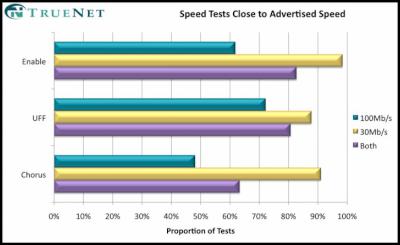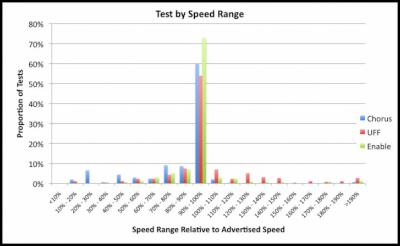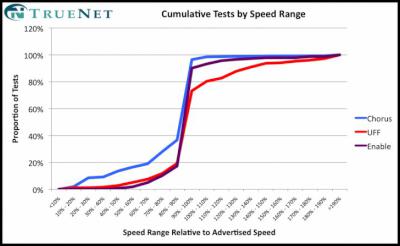Chorus Speed Tests Trail other Fibre Companies
Chorus Speed Tests Trail other Fibre Companies
Ultra Fast Broadband Connections
TrueNet's latest test results reveal that on Chorus supplied 100Mb/s connections less than half of tests from our Auckland or Wellington servers are better than 90% of the advertised speed.
Ultra Fast Broadband (UFB) provides an internet connection using fibre to homes and is available in some suburbs throughout New Zealand. UFB fibre is supplied by a Local Fibre Company (LFC) and internet connections over UFB are sold to the public through many Internet Service Providers (ISP) selling UFB fibre services.
Local Fibre Companies (LFC)
Chorus provide Fibre connections throughout New Zealand excluding regions where three other LFCs have exclusive rights of supply. These being - Ultra Fast Fibre (UFF in Waikato, Manawatu, Bay of Plenty); Enable ( in Christchurch, Canterbury); and Northpower (in Northland).
ISP Speed Constraints
ISPs sell UFB plans by Speed - currently either 100 or 30 Mb/s, but TrueNet's test results show that these speeds are not possible, the most common maximum download speeds are approximately 94 and 28 Mb/s.
Speed Tests
During October, TrueNet had sufficient fibre connected Volunteers to provide a comparison between three different LFCs.Northpower did not have sufficient Volunteers for TrueNet to report their speed results.
It should be noted that ISPs are more likely to influence the performance of each Volunteer's connection during busy times; so we have compared the off-peak hours of midnight to 8am and selected the best speeds achieved at each time from either Auckland or Wellington. This is to ensure that the speed measurement more closely relates to the peak performance achievable with each LFC.
Chart 1: Comparison of LFC Speeds

Click for big version.
Chart 1: The horizontal axis is a measurement of the proportion of tests that achieve the advertised speed. The 30Mb/s product was much more likely to reach TrueNet's target speed of 27Mb/s, especially for Enable where almost 100% of all tests were better than 27Mb/s.
For the premium 100Mb/s product less than 70% of all LFCs tests achieved better than 90Mb/s for the premium 100Mb/s product.
Tests from Volunteers on the Enable (Christchurch) network, showed most successful results for the 30Mb/s tests; with Ultra Fast Fibre (UFF - Hamilton) having the best results in the 100Mb/s tests.
Chorus (rest of NZ) was a close second for the 30Mb/s tests with over 90% of tests better than 27Mb/s. For the 100Mb/s tests less than 50% of results reached the advertised speed. This poor result dragged down their overall average speed.
Taking the average of both 30Mb/s and 100Mb/s speed test results, Enable came out on top closely followed by UFF, with Chorus lagging behind in third place.
How will this effect Customers' Internet Download Experience?
1. LFC's need to ensure that their advertised speed is available for ISPs to sell. This may mean the LFC's need to provide higher speeds than those advertised.
2. ISPs and LFCs may need to work together to ensure they deliver the best product possible, so that the advertised speed can be achieved .
It is possible that in some cases poor performance may be due to the interface between the LFC and the ISP.
TrueNet's latest comparisons show that work needs to be done on performance to ensure the Ultra Fast Broadband (UFB) project is fully successful.
More Details for Experts
The distribution of test results demonstrate some unusual features. Policing and shaping are methods that can manage a peak speed, but since speed can only be measured over finite periods, the results of our tests can "burst" higher than the specified speed.
Chart 2 and 3 show the differences in Burst test results, where Enable is similar to UFF for slower tests, but similar to Chorusfor tests above the specified speed.
UFF have a higher probability of faster tests, a small number getting much faster than expected, however extreme results are likely due to clock-errors and should be ignored.
A note from UFF explains the speeds greater than 100%: "We have reasonable burst sizes which you might be seeing the effect of. For example a 30 Mbps downstream has a burst size of 980k bytes so files smaller than this may flow through before the policers kick in. We are reviewing our burst sizes in light of industry discussions."
TrueNet tests are 1MB to enable many tests at different times without exceeding the data limits of our volunteer's connections. A 980kB burst size could almost encompass an entire test, but as is visible below, over 100% results are rare.
Chart 2: Distribution of Test Results

Click for big version.
Chart 3: Cumulative distribution of Test results

Click for big version.
UFB Speed Reports
In future, TrueNet plans to publish Ultra Fast Broadband speeds when test results show some evidence of extremes outside of the advertised speeds.
We are experiencing a gradual increase in UFB Volunteers, but without support and involvement from ISPs and LFCs we cannot provide regular updates of our fibre speed tests.
ENDS


 Stats NZ: Annual Number Of Home Consents Down 7.4 Percent
Stats NZ: Annual Number Of Home Consents Down 7.4 Percent Plains Media: Plains FM Announces Name Change After 37 Years
Plains Media: Plains FM Announces Name Change After 37 Years NIWA: Flooding From Underneath - New Tool Reveals Shallow Groundwater Elevations
NIWA: Flooding From Underneath - New Tool Reveals Shallow Groundwater Elevations Commerce Commission: Commission Concludes Auckland Airport Over-charging By $190 Million
Commerce Commission: Commission Concludes Auckland Airport Over-charging By $190 Million The Future Is Rail: Ferry Decision - Common Sense Prevails
The Future Is Rail: Ferry Decision - Common Sense Prevails Aotearoa Food Rescue Alliance: Grocery Market Reform Must Include Mandatory Food Rescue Partnerships
Aotearoa Food Rescue Alliance: Grocery Market Reform Must Include Mandatory Food Rescue Partnerships



